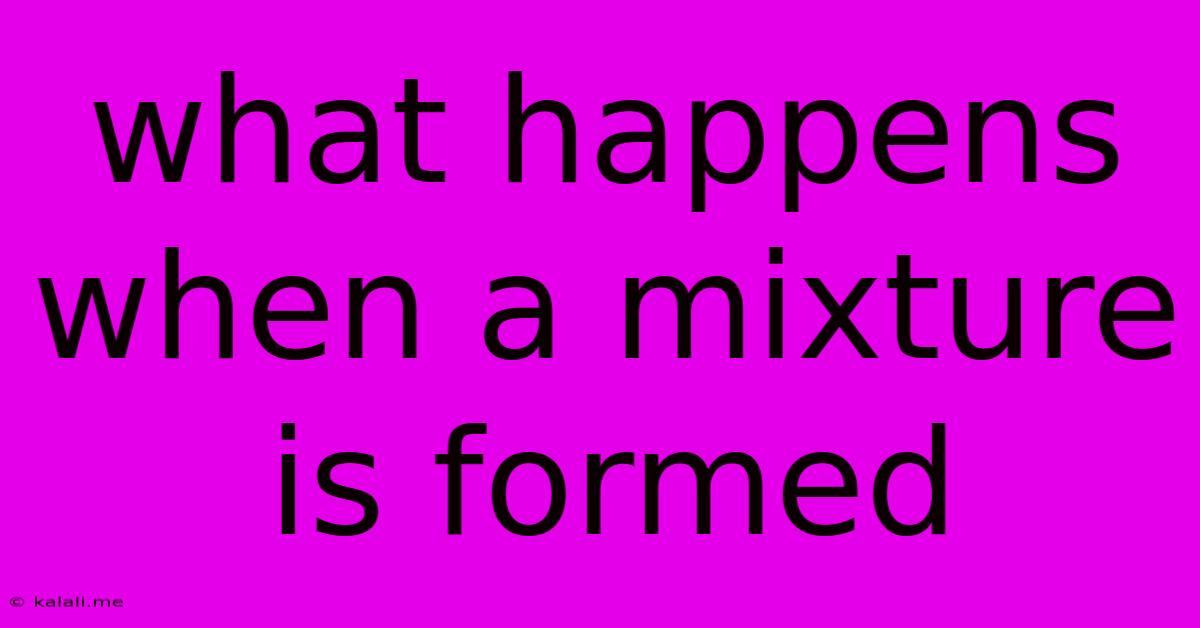What Happens When A Mixture Is Formed
Kalali
Jun 15, 2025 · 3 min read

Table of Contents
What Happens When a Mixture is Formed? A Deep Dive into Physical Combinations
What happens when you combine salt and pepper? Or mix oil and water? The answer lies in understanding mixtures. This article explores the fascinating world of mixtures, explaining the processes involved when substances combine without undergoing chemical changes. We’ll delve into different types of mixtures, the properties they exhibit, and the key differences compared to compounds.
Understanding Mixtures: A Definition
A mixture is a substance comprising two or more components not chemically bonded. A crucial characteristic is that the components retain their individual chemical properties. This means you can, in principle, separate them using physical methods. Think about it – you can easily separate salt and pepper using a sieve because they remain salt and pepper, chemically unchanged. This is in contrast to a compound, where the constituent elements combine chemically to form a completely new substance with distinct properties.
Types of Mixtures: Exploring the Variety
Mixtures aren't all created equal. They fall into two main categories:
1. Homogeneous Mixtures: Uniformity Reigns
In a homogeneous mixture, the components are evenly distributed throughout. You won't be able to distinguish the individual components with the naked eye. Examples include:
- Saltwater: The salt dissolves completely into the water, creating a uniform solution.
- Air: A mixture of various gases like nitrogen, oxygen, and carbon dioxide, blended seamlessly.
- Brass: An alloy of copper and zinc, appearing as a single, solid phase.
The key characteristic here is uniformity at a macroscopic level. Even though different molecules are present, they're distributed so evenly that the mixture appears visually uniform.
2. Heterogeneous Mixtures: A Patchwork of Components
In a heterogeneous mixture, the components are not uniformly distributed. You can easily distinguish the different parts visually. Examples abound:
- Sand and water: The sand particles are clearly visible within the water.
- Oil and water: These two liquids separate into distinct layers due to their different densities.
- Salad: A mixture of various vegetables, each maintaining its own identity.
The lack of uniform distribution is the defining feature. Different regions of the mixture will have different compositions and properties.
What Happens at the Molecular Level?
When a mixture is formed, the molecules of the different components simply intermingle. There's no rearrangement of atoms or formation of new chemical bonds. In homogeneous mixtures, the attractive forces between the molecules of different components allow for even distribution. In heterogeneous mixtures, differences in these forces often lead to segregation or distinct phases. For instance, in oil and water, the stronger intermolecular forces within each liquid overcome the forces between oil and water molecules.
Separating Mixtures: Utilizing Physical Methods
Because mixtures don't involve chemical bonding, they can be separated using physical methods. These include:
- Filtration: Separating solids from liquids (like sand from water).
- Distillation: Separating liquids based on their boiling points.
- Evaporation: Separating a dissolved solid from a liquid (like salt from saltwater).
- Chromatography: Separating components based on their differing affinities for a stationary and mobile phase.
- Magnetic Separation: Separating magnetic materials from non-magnetic materials.
The choice of separation technique depends on the specific mixture and the properties of its components.
Mixtures vs. Compounds: A Critical Distinction
It’s vital to remember the key difference between mixtures and compounds. Compounds are formed through chemical reactions, resulting in the formation of new substances with unique properties. Mixtures, on the other hand, are merely physical combinations of substances that retain their individual identities. This distinction is fundamental in chemistry and impacts various fields, from material science to environmental studies.
In conclusion, the formation of a mixture involves the physical combination of substances without any chemical change. Understanding the different types of mixtures and the methods used to separate them is crucial in many scientific disciplines and everyday applications. By grasping the fundamental principles discussed here, you'll gain a much deeper understanding of the world around us.
Latest Posts
Latest Posts
-
Boiling And Freezing Point Of Water
Jun 15, 2025
-
The Figure Shown Has A Total Area Of 168cm
Jun 15, 2025
-
Which Of The Following Is Not A Health Related Fitness Component
Jun 15, 2025
-
How Many Milliliters Are In 2 Tbsp
Jun 15, 2025
-
What Is Square Root Of 4096
Jun 15, 2025
Related Post
Thank you for visiting our website which covers about What Happens When A Mixture Is Formed . We hope the information provided has been useful to you. Feel free to contact us if you have any questions or need further assistance. See you next time and don't miss to bookmark.